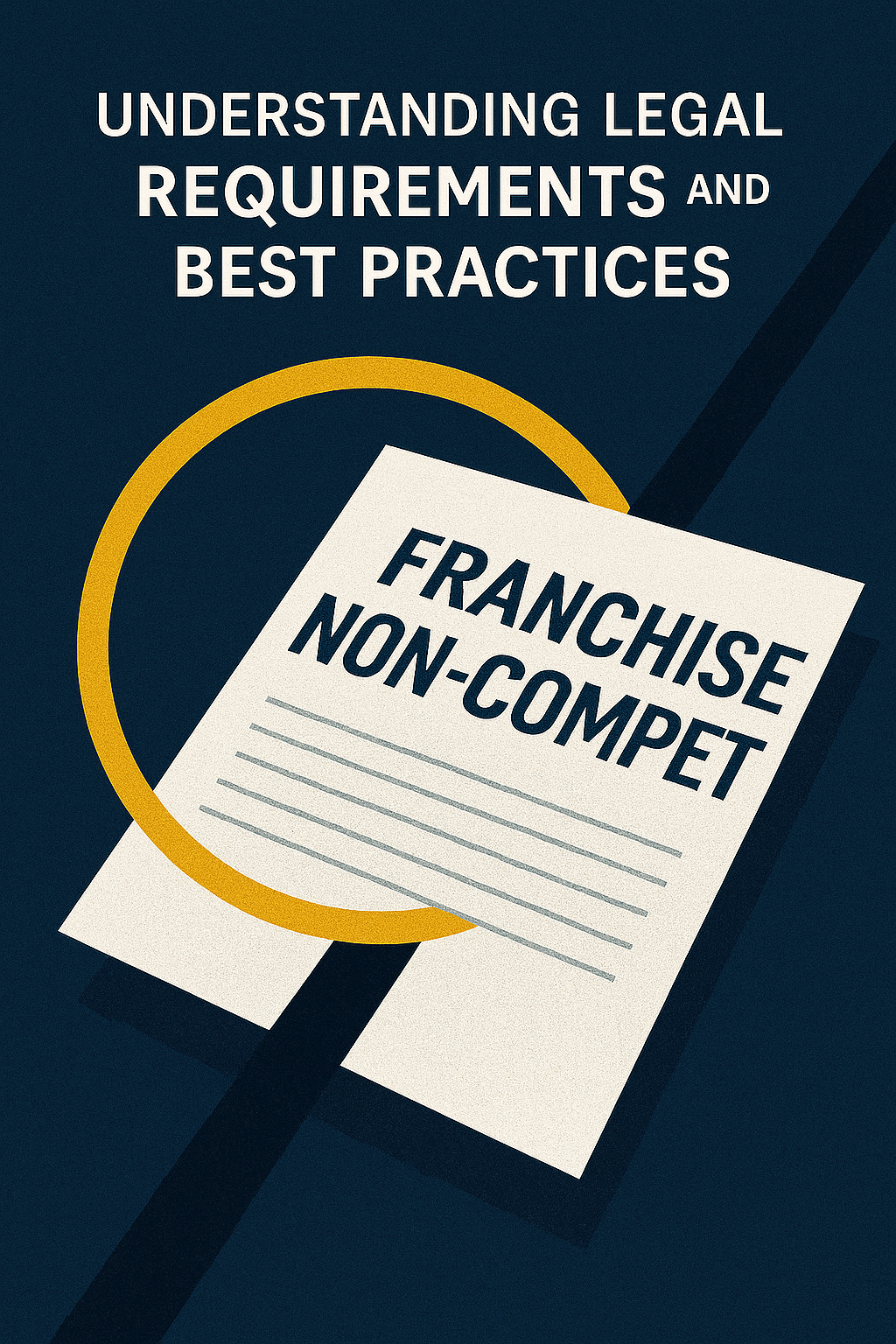Changes in franchise agreements are reshaping the fast food industry. Driven by evolving consumer preferences, franchisees must understand these updates to stay competitive. This article breaks down the key changes, including financial commitments, support, and legal frameworks, under the theme of “stay fresh or fall behind: analyzing the franchise agreement changes in the fast food industry.” Learn how keeping up with these changes can help you stay ahead in the fast food business.
Understanding the importance of the franchise disclosure document is crucial in comprehending the changes in franchise agreements.
Key Takeaways
Franchise agreements in the fast food industry have evolved to balance brand consistency with local adaptation, incorporating sustainability practices and innovative methods to strengthen the franchisor-franchisee relationship.
Modern franchise agreements have introduced substantial changes, including increased financial obligations, enhanced support and training provisions, and updated territory and exclusivity clauses to better align with industry dynamics and improve franchise performance.
Understanding and navigating legal frameworks, compliance issues, and updated financial metrics related to franchise performance are crucial for franchisees to maintain profitability and ensure that the franchise operates within regulatory boundaries while leveraging technology integration to meet market demands.
The Evolution of Franchise Agreements in the Fast Food Industry

Franchise agreements have been fundamental in propelling the fast food industry forward, marrying the ambitions of franchise owners with the strategic plans laid out by franchisors. Traditionally, these contracts were rich with safeguards for franchisors to preserve a uniform brand image across all separate franchise locations. The basic trade-off involved granting access to the use of the franchisor’s branding and expertise in exchange for the franchisee’s capital investment and hands-on effort.
The landscape of fast food franchises has undergone significant changes, bringing about an evolution in these agreements. Presently they seek an equilibrium that permits franchisees some flexibility to customize their operations according to local preferences while upholding the core essence of the wider brand identity. The franchise system has evolved to balance local customization with brand consistency, ensuring that franchisees can adapt to local markets while maintaining the overall brand standards. Thus, today’s franchise agreements are continually evolving documents offering provisions like sustainable business practices and novel approaches towards food preparation methods.
This shift goes beyond simply incorporating fresh elements into existing frameworks. It is about reinforcing positive connections within each partnership between franchisor and owner. Current-day contracts provide dual benefits: safeguarding a company’s intellectual property rights while shaping structured collaborations conducive to nurturing prosperous enterprises under one umbrella model – including details pertaining to legal constructs:
fiscal responsibilities
support mechanisms
critical conditions governing contract cessation or renewal
The franchise model plays a crucial role in this evolution, defining the structure and dynamics of franchising. It encompasses the relationship between the franchisor and the franchisee, the types of franchise models, and the components of a franchise agreement. This model ensures that each franchise operates under a consistent framework while allowing for necessary adaptability to meet contemporary client demands.
Behind every successful fast outlet lies deliberate planning through its foundational agreement structure — which acts as a linchpin enabling control over maintaining high-quality standards throughout franchises uniformly tied back into ensuring recognition for consistency amidst excellence among products offered by different chains on global platforms providing guidance tailored around goal-oriented competitive landscapes designed specifically toward capturing more segments spurring interest from top-tier entrepreneurial prospects seeking opportunities involving building respective branches essentially contributing toward legacy continuance vitalizing structures themselves drawing attention especially near market-leading edges where one competes against other major players nestled closeby theoretically speaking at least
Recognizing thus foregrounds current necessity wherein necessary adaptability transforms historic traditions amid new ways responding adequately to emerging contemporary client demands reflecting extended visionary perspectives preparedness encompassed potential surges hence undertaking optimizations constant actions engaged realign both parties partaking common ends pursuing agentive dynamics around efficacious output cycles guarantee return investments alongside affirmative progression growth scale networks overall.
Key Changes in Modern Franchise Agreements
Delving deep into the core of the subject, it becomes evident that contemporary franchise agreements in the fast food industry have experienced significant alterations. These changes are far from minor adjustments. Rather, they fundamentally transform what constitutes a fast-food franchise. Changes in franchise law have influenced the new financial obligations and support provisions. The aspects revised include not only the financial obligations imposed on franchise owners, but also their access to improved support and training, as well as crucial stipulations related to territorial rights and exclusivity—all designed to resonate with the swift advancement of this sector. Fast food chains, in particular, have been impacted by these changes, with technology, consumer preferences, and sustainability playing pivotal roles in shaping new franchise agreements.
New Financial Obligations and Franchise Fees
The franchise business landscape is dynamic and financially demanding. Detailed within the franchise agreements are the financial obligations, including both an initial franchise fee for entering into the agreement and ongoing royalties to maintain a smooth operation of the franchise system. These fees constitute essential revenue for franchisors, funding continuous support and future improvements. Franchise owners must stay keenly aware of these expenses as they affect their net income directly.
With larger fast food franchises such as McDonald’s upping their royalty rates from 4% to a rather hefty 5%, there has been a notable rise in costs associated with starting a new venture. Peers like Wendy’s and Burger King linger between 4% to 6%, while Subway demands an even higher royalty rate at 8%. Additional expenditures can pile on due to requirements ranging from updating menus or tech infrastructure upgrades, all while aspiring towards eco-friendly operations—a challenge that necessitates astute management by franchisees aiming to sustain palatable profit margins.
Compulsory marketing fees have also wormed their way into many fast food franchises’ contracts, obliging investments into communal advertising funds aimed at keeping brands competitive in consumer markets. This imposes another fiscal consideration for budgeting purposes among franchisees. Such investments can stir discontent during times when sales aren’t exactly booming—times which amplify monetary strains on those who manage these branded businesses.
Enhanced Support and Training Provisions

In the realm of franchising, a chain is no stronger than its weakest link, emphasizing why provisions for advanced support and ongoing training are fundamental components in franchise agreements. Such measures grant each franchisee critical knowledge and assistance required to effectively run their establishment according to the brand’s standards, contributing to the success of individual franchise locations. Effective initial training programs establish groundwork for operational efficiency while continued backing preserves overall vitality and contributes to long-term success.
Franchise contracts often incorporate extensive educational modules that cover diverse topics from culinary techniques to client relations management, arming franchisees with necessary resources aimed at upholding quality norms and fostering high levels of customer satisfaction. Beyond education, franchisors deliver continual reinforcement through marketing aid, strategic guidance, as well as sharing successful practices—forming a collaborative dynamic anchored by mutual reliance with an objective focus on preserving uniformity across disparate elements within the business model. Enhanced support and training provisions strengthen the franchise relationship by ensuring franchisees feel confident and capable, which in turn fosters loyalty and commitment to the brand.
The role of persistent coaching coupled with sustained auxiliary services is crucial. It acts as essential infrastructure enabling every franchise holder’s progression towards commercial objectives while staying aligned with shifts in industry patterns along with alterations intrinsic to the brand itself. While franchisors pledge these supports as part of all-encompassing package deals within their business framework obligations they offer. Equally imperative is for owners within franchises—that endorse such facilitations—to wholeheartedly participate using provided means optimally thus amplifying personal economic gain alongside boosting overarching benchmarks tied directly linked back into aggregate performance outcomes related specifically towards this specific structured enterprise system.
Updated Territory and Exclusivity Clauses
The world of fast food franchising is not just about who has the crispiest fries or the juiciest burgers—it’s also about where you serve them. The territorial rights outlined in franchise agreements define the geographical stage on which franchisees can perform their culinary symphonies. Exclusivity clauses add another layer, shielding franchisees from internal competition and allowing them to craft their unique brand of hospitality within their local markets. Updated territorial and exclusivity clauses help franchisees better meet consumer preferences by adapting to local market dynamics and consumer demands.
These clauses have been updated to reflect the changing landscape of consumer demands and local market nuances. Such scrutiny ensures that franchise agreements remain flexible enough to allow franchisees to:
Stay ahead of the curve
Expand their business
Innovate
Sell the franchise in the future
Understanding these territorial rights and restrictions is crucial, as they can make or break a franchisee’s ability to achieve these goals.
The art of franchising is to maintain a global symphony while allowing for local improvisations. Updated territory and exclusivity clauses in franchise agreements serve as the conductor’s baton, guiding franchisees in harmonizing their operations with the franchisor’s overarching brand melody. It’s a performance that requires finesse, ensuring that the brand’s core values resonate in every location while allowing for the local flavor to flourish.
Implications of Franchise Agreement Changes on Franchisee Profitability
In the domain of fast food, the financial success of a franchise is just as crucial as what it serves up to customers. Franchise owners must constantly monitor the economic indicators embedded within their operations due to modifications in franchise agreements. The erosion of profit margins by rising expenses from inflationary pressures, technological enhancements, and shifts toward sustainable practices are notable factors that nibble away at profitability. Amendments to these agreements can shake things up significantly, impacting both fiscal stability and the collaborative effectiveness between franchisor and franchisee. Successful franchises master financial health and operational efficiency, ensuring they remain profitable and competitive. They manage to maintain profitability despite changes in franchise agreements by adapting their business models and optimizing cost management strategies.
It’s absolutely vital for proprietors to grasp every financial detail presented in the franchise disclosure document. Failure to do so isn’t an option if they wish to avoid monetary turmoil—the overlooked details pertaining to fees, royalties, and marketing obligations may very well concoct disarray in finances. Conscientious tracking of metrics such as revenue, margin, and return on investment (ROI) are critical instruments for gauging successful performance. These diagnostics serve as thermometers monitoring the health and vitality of operations. Against this industry backdrop, pursuing opportunities for enhanced offerings by benchmarking robust standards paints an accurate position amidst the landscape, where scrutinization of cost management techniques and pricing policies play a pivotal role in reinforcing the overall network.
Franchise operators must champion competency in budgetary scrutiny to achieve longstanding expansion. Truly immersing themselves in the minutiae of reports and deciphering expenses lays the foundation to safeguard peak capital efficiency. Enduring enterprise demands a keen calibration approach wherein slight refinements portend considerable implications for the bottom line.
The ramifications stemming from alterations in deals directly touch upon earning capabilities, making it essential to be alert and responsive. Making judicious decisions that resonate with objectives, blending numerical acumen with strategic planning, is key to cultivating prosperous ventures. Any deviation from precision could translate into expensive errors.
Navigating Legal Frameworks and Compliance
Entering the intricacies of franchise law unveils a demanding environment filled with obligations and standards. More than an in-depth knowledge of the franchise agreement is needed—strict adherence to both local regulations and the wider legal landscape is paramount. Understanding franchise law is crucial in navigating legal frameworks and ensuring compliance with regulatory standards. At its heart, the franchise relationship utilizes intellectual property provided by franchisors, which these agreements solidify, thus enabling the growth and development of any given franchise business.
Franchise contracts are binding instruments that dictate not only mutual comprehension but also explicitly define aspects such as operation methods, site selection, terms duration, and fee structures inherent to franchises. The responsibilities each party shoulders within this context are clearly defined: for instance, ensuring quality benchmarks are met or operational procedures followed closely. It’s crucial to realize that consequences can be dire when parties fail to uphold their contractual commitments. Repercussions like litigation can emerge from discrepancies between practices employed at individual locations versus stipulated brand guidelines.
Amendments made within such agreements often mirror shifts in market dynamics or alterations in legislative mandates necessitating adjustment on part of participating entities—in other words, modification emerges out necessity whether addressing ecological considerations or technological integration concerns across various operations underpinned by contemporary statutes governing data privacy alongside additional protocols pertaining thereof have become increasingly salient within current discourse circling around provisions upheld under licensing arrangements unique to the sector itself.
Enlisting professional counsel bears significant importance throughout all aspects connected directly to crafting fortifying modifying amending etcetera licenses provides critical infrastructure designed to safeguard those actively engaged either side equation rendering services indispensable when enacting newly conceived developments reinforcing pre-existing conditions overseeing documents alignment enforcement policies set forth Federal Trade Commission among other things hence constitutes sound course action bound yield long-term benefits incumbent operators alike.
Ultimately mastery commercial regulatory hurdles linked essential producing viable framework governed stringent expectations placed managers Ensuring entirety complex conduit erected therein complies fully extends reach requisite norms established protect integrity essence fundamental ensure flourishing establishment sustained measured compliance indicators drawing parallels culinary process whereby exacting precision amalgamation technique imperative achieving optimal outcome synonymous satisfying rigorous demands imposed setting simultaneously respecting sanctioned procedural dictates industry-wide.
Balancing Brand Standards with Local Adaptation
The intricate process of merging the universal appeal of a brand with local nuances is essential within the franchise sector. Franchise agreements outline this complex interplay, delineating guidelines for franchisees while permitting adjustments that meet local preferences. Striking the right balance demands skill—to preserve the unique identity of a fast food franchise while also catering to varied consumer tastes across multiple regions. The franchise model allows for balancing brand standards with local adaptation, ensuring that the core values of the brand are maintained while also embracing regional uniqueness.
Established brand standards act as a cornerstone for structuring a solid and consistent franchise system. They guarantee consumers worldwide will encounter consistent quality and ambiance reflective of the brand’s heart and soul. Deviation from these established norms isn’t tolerated, as it can inflict severe damage or even dilute overall branding strength. Despite this rigidity, contemporary agreements incorporate flexibility that empowers franchises to innovate with new menu offerings attuned to regional dietary inclinations.
By embracing such malleability, franchises connect more deeply with communities by incorporating regional specialties into their existing lineup—offering something globally recognized yet locally distinctive simultaneously appeals closer to homefronts everywhere. This calculated integration boosts customer gratification and nurtures fidelity toward an adaptable but reliable dining experience.
Nonetheless, maintaining cohesiveness in upholding strict corporate tenets alongside enabling some degree of adaptation involves precise management akin synchronization efforts between all involved parties are paramount. Clear-cut yet accommodating terms within each agreement must be formulated smartly so franchises remain true representations without missing out on localized market opportunities when crafted adeptly enough leads them towards synergizing widespread attraction effortlessly aligning side-by-side hometown allure seamlessly weaved together.
Ultimately carrying out effective juggling acts regarding consistency versus customization realms falls similarly conducting magnificent ensembles where every restaurant adds individual flair while perfectly matching ensemble concert constructing global culinary narrative resonates warmheartedly amongst patrons universally.





